Ministering through Music
Keyboard to Keyboard
¡Cantemos Amén!
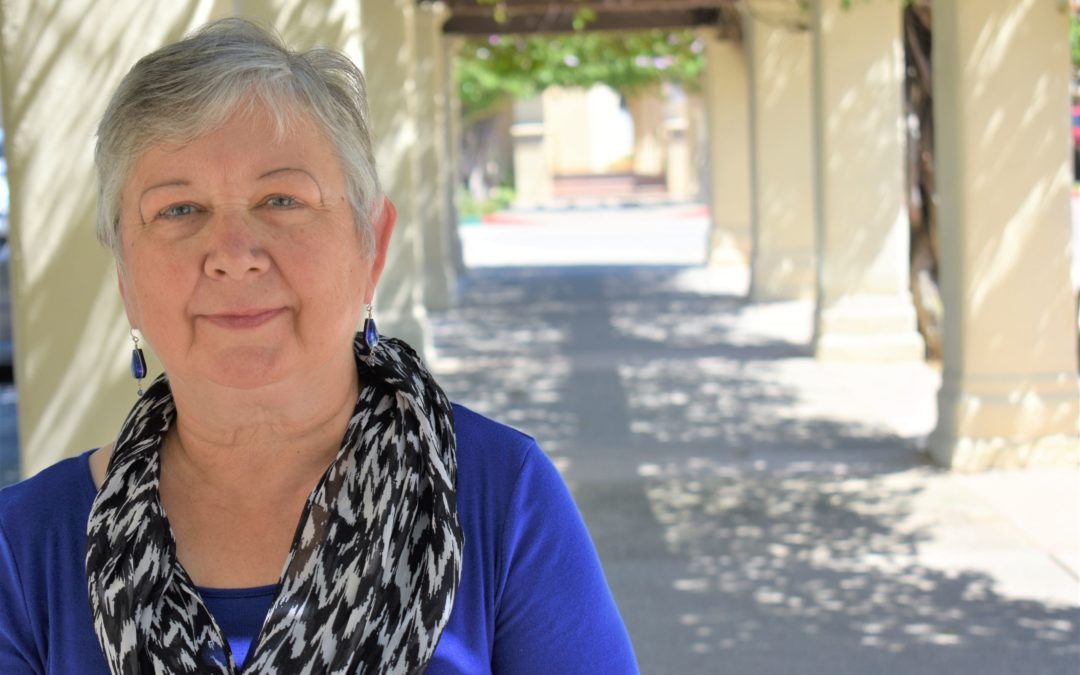
Unknown Blessings: A Conversation with Carol Browning (Sing Amen! the Podcast, episode 26)
Podcast: Play in new window
We’re back! Sing Amen took a little hiatus after Christmas, but here at last is our first podcast of the new year. As most people know by now, World Library Publications has officially joined GIA as a new division of the company, and the past couple of months have been full of transitions and moves and new and old friends working together—it’s a very exciting time, and we are all eager to see what the future brings!
Today’s podcast is an interview with Los Angeles composer Carol Browning, who was kind enough to sit down for about half an hour with me when she was in Chicago to record her new collection, Unknown Blessings, which is newly released and will be featured at next week’s Los Angeles Religious Education Congress. It was a delightful conversation, about her background and her process as a composer, and about the new collection—we will hear a few selections from it as well.
So enjoy!
Music heard on today’s podcast:
We Remember—G-7332
As Recorded on Come and Receive, CD-757
Indwelling Christ—G-9769
As Recorded on Unknown Blessings, CD-1069
Let Us Give Thanks for Unknown Blessings—G-10057
As Recorded on Unknown Blessings, CD-1069
You Call Us Lord—G-5890
As Recorded on Unknown Blessings, CD-1069
Lord Jesus Christ—G-5905
As Recorded on Come and Receive, CD-757
Sing Amen! the Podcast, with Jennifer Kerr Budziak
Sound by Jim Bogdanich
Sing Amen! closing music: Amen, (from More Sublime Chant, CD-459, The Cathedral Singers, Richard Proulx, conductor. ©GIA Publications, Inc.)
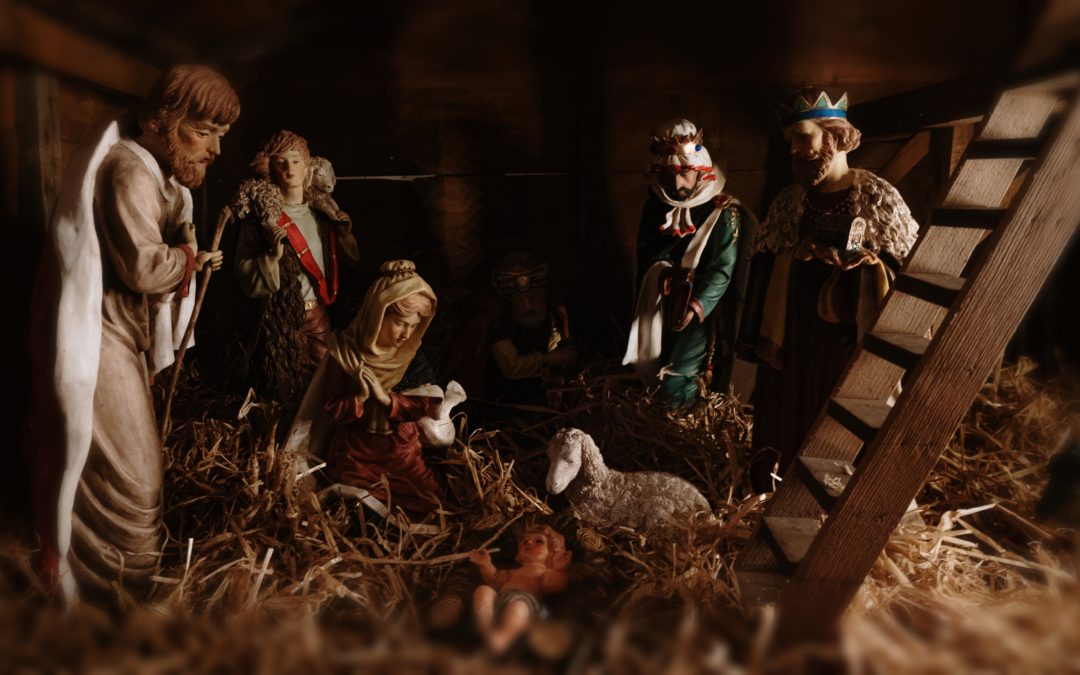
Gloria in Excelsis!–A Christmas Playlist (Sing Amen! the Podcast, episode 25)
Podcast: Play in new window
A Merry Christmas to everyone! If I did this right, this podcast dropped at right about midnight on Christmas Eve, and we hope you enjoy this gift of an hour or so of lovely Christmas choral music to let sing and play through your holy day!
A word of welcome to our new subscribers—and if you are not a subscriber yet, please be aware that you can subscribe to us via Apple Podcasts, Google play or Stitcher, and listen through your regular podcast app. Depending on how you got here, the links to subscribe might be right at the top of this page, or else you can click the “podcast” link at the top of the page and that will take you there. (Of course, you can always listen here on the website as well.)
We hope you enjoy this music–me being me, it is unabashedly choral, because that’s what I love. If it helps keep you awake during a drive to a relative’s house for Christmas dinner once all your liturgies are done, that would be wonderful; if it helps put you to sleep after dinner and slip into a nice peaceful post-liturgical nap, that’s wonderful too.
Wishing you all good things–Merry Christmas to all, and God bless us, every one!
–Jennifer
Music heard on this episode:
People Look East (G-6570)
For brass, organ and timpani
Arranged by: Sondra K. Tucker
Comfort, Comfort Ye My People (G-2893)
by Louis Bourgeois , Claude Goudimel
Edited By: Anne Heider
Angels We Have Heard on High (G-7603)
Arranged by: Eric M. Pazdziora
Bring a Torch, Jeanette, Isabella
Arranged by Richard Proulx
As Recorded on Catholic Christmas Classics, CD-590
Como Estrella en Claro Cielo / As a Star on Cloudless Evenings (G-6405)
by Skinner Chavez-Melo , Arranged by: Richard Proulx
En Natus Est Emmanuel (Praetorius) (G-5075)
From Psallite: Four Classic Motets for Christmas and General Use
by William Byrd , Johann Walter , Michael Praetorius
Come Gladly, Come Gaily, Come Gather Together! (G-6077)
by Bob Moore
Text by Sylvia Dunstan
As Recorded on Like a Whisper in the Heart, CD-558
A La Nanita Nana (SSA chorus) (W5000)
Arranged by: Norman Luboff
Hark! The Herald Angels Sing (G-9281)
Concertato on MENDELSSOHN
Arranged by: Robert J. Powell
Go Tell It on the Mountain (G-8106)
Arranged by: Evelyn Simpson-Curenton
Folly and Love (G-5490)
Text and Music: John L. Bell
As recorded on God Comes Tomorrow (CD-494)
Voces Angelorum (G-5496)
Text and Music: John L. Bell
As recorded on God Comes Tomorrow (CD-494)
Good Christian Friends, Rejoice (G-8341)
Arranged by: David Sims
A La Ru (G-6466)
Arranged by: John Donald Robb , Richard Proulx
As Recorded on Catholic Christmas Classics, CD-590
A la Rorro Niño (G-3813)
Arranged by Donna Peña and Marty Haugen
No Wind at the Window (G-7480)
Text by John Bell
Arranged by: Jennifer Kerr Budziak
The Angel Gabriel from Heaven Came (WW1660)
Arranged by: Susan LaBarr
Still, Still, Still (W3003)
Arranged by: Norman Luboff
Gaudete! (WLG149)
Arranged by: Michael Engelhardt
The First Nowell
Arranged by Richard Proulx
As Recorded on Catholic Christmas Classics, CD-590
Sing Amen! the Podcast, with Jennifer Kerr Budziak
Sound by Jim Bogdanich
Sing Amen! closing music: Amen, (from More Sublime Chant, CD-459, The Cathedral Singers, Richard Proulx, conductor. ©GIA Publications, Inc.)
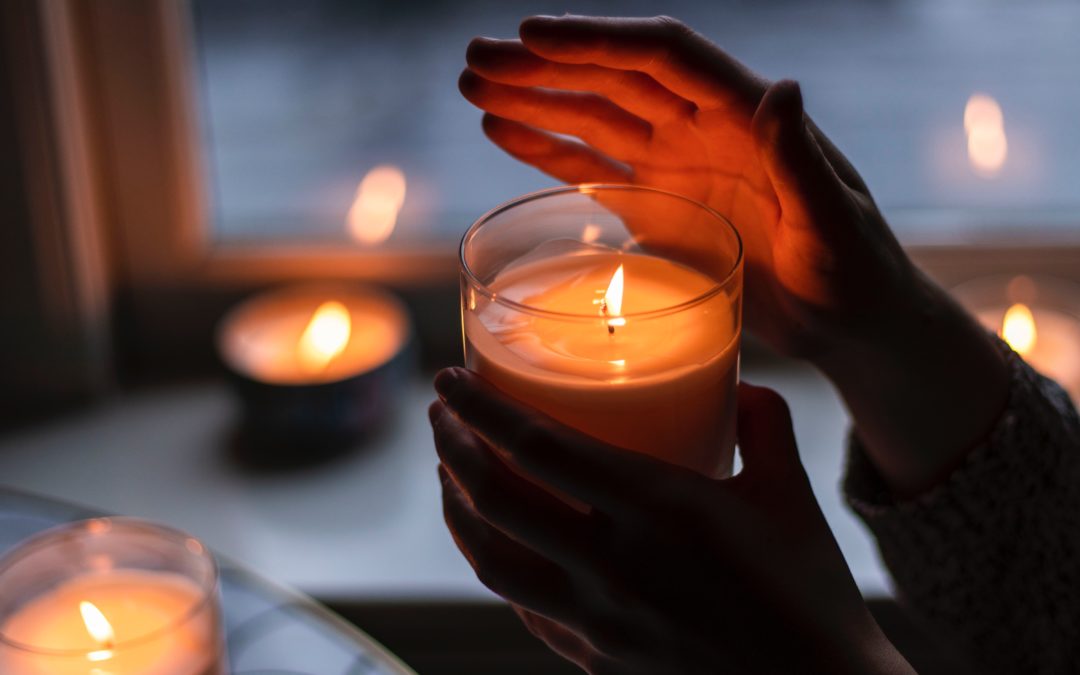
A Song of Thanksgiving! (Sing Amen! The Podcast, episode 24)
Podcast: Play in new window
This episode is simply a lovely sampler of music, in various styles, to help us all move deeper into a spirit of gratitude and grace–peace to you all, and from all of us at GIA Publications, prayers and blessings for a beautiful Thanksgiving week!
(Eat well, and get some rest. Advent is almost here. 😉 )
–Jennifer
Music heard on today’s podcast:
Now Thank We All Our God (for organ and brass) (G-4765)
by Johann Sebastian Bach , arr. Hyslop
As recorded on Gaudeamus, CD-503
Halleluya! We Sing your Praises!
South African Spiritual
As recorded on 49 Hidden Treasures from the African American Heritage Hymnal, CD-636
For the Beauty of the Earth (G-6603)
by Bernard Sexton
For the Beauty of the Earth (G-9323)
Text and arr.: Jeanne Cotter
O God beyond All Praising (G-3190)Concertato on THAXTED
by Gustav Holst, arr. Proulxas recorded on Rare Beasts and Unique Adventures Volume 2, CD-468
Now Thank We All Our God (G-7476)
by Johann Pachelbel , ed. Lovelace
In Christ We Come to Offer Thanks (G-9719)
by J. Michael Joncas, Text by Delores Dufner OSB
As recorded on Deep and Lasting Peace, CD-1047
Thank You, Jesus (G-6678)
Arranged by: J. Weldon Norris
Bless the Lord!
Psalm 103; music by Andraé CrouchAs recorded on 42 Treasured Favorites from the African American Heritage Hymnal, CD-742
Let Us Give Thanks for Unknown Blessings (G-10057)
by Carol Browning
As recorded on Unknown Blessings CD-1069
Come, You Thankful People, Come (G-9460)
by George J. Elvey , arr. Alonso
As recorded on Revival, CD-1012
Let All things Now Living (piano solo) (in G-9491)
Arr. Paul Tate
As recorded on Seasons of Grace, Vol. 7, CD-1028
Sing Amen! the Podcast, with Jennifer Kerr Budziak
Sound by Jim Bogdanich
Sing Amen! closing music: Amen, (from More Sublime Chant, CD-459, The Cathedral Singers, Richard Proulx, conductor. ©GIA Publications, Inc.)
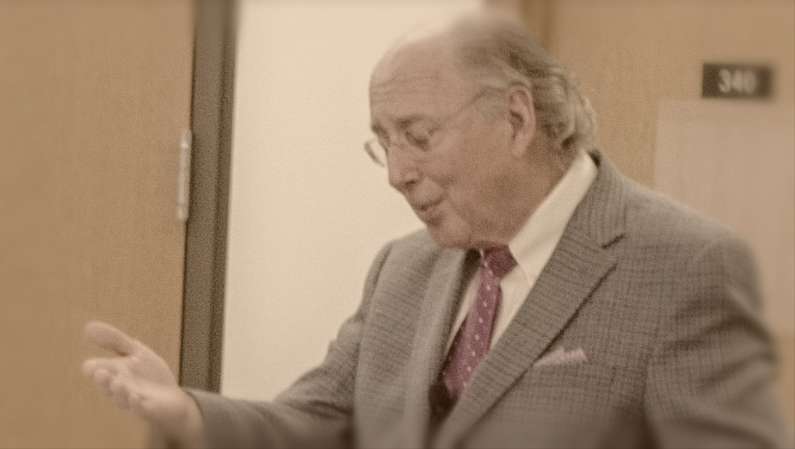
Igniting Choral Rehearsals–a conversation with Michael Kemp. (Sing Amen! the podcast, episode 23)
Podcast: Play in new window
Today we have a conversation with choral conductor Michael Kemp, who has written several books including The Choral Challenge, Innovative Warm-ups for the Volunteer Choir, Rejuvenating Senior Voices (this book helps choir directors help our singers to deal with the vocal issues that begin to affect them as they age,) and his most recent book, Igniting Choral Rehearsals with Efficiency, Artistry, and Motivation. I had the privilege of helping to edit this last book, and it’s a really excellent and practical handbook for choral conductors looking for ways to approach your choir rehearsals that will not only be more efficient and accomplish more, but also be more fun and stimulating for everyone involved. The book suggests specific areas of focus that we can be looking at simultaneously, in layers, as we work on a piece, rather than saying, “Okay, let’s learn the notes, and then we can work on musicality, or dynamics, or vowel formation, or whatever other elements of the piece need work. And after laying out what some of those layers are, he offers 17 octavos, analyzed and score-marked the way he would to go into a rehearsal, taking the concept out of the theoretical and into something concrete and incredibly practical.
I recorded this interview with Michael over a year ago at the last NPM convention he spoke at (pardon the street noises and sirens!), and I’m delighted to finally be able to get this one out into the world.
Music Heard in Today’s Podcast:
O Lord, Increase My Faith, G-2900 (Orlando Gibbons)
Were you There, G-8911 (arr. Marques L. A. Garrett)
Panis Angelicus, G-8655 (Zack Stachowski)
Sing Amen! the Podcast, with Jennifer Kerr Budziak
Sound by Jim Bogdanich
Sing Amen! opening music: Promenade, by Bob Moore (from Let Every Instrument Be Tuned for Praise, CD-491, from Liturgical Suite #4, G-4789 ©GIA Publications, Inc).
Sing Amen! closing music: Amen, (from More Sublime Chant, CD-459, The Cathedral Singers, Richard Proulx, conductor. ©GIA Publications, Inc.)
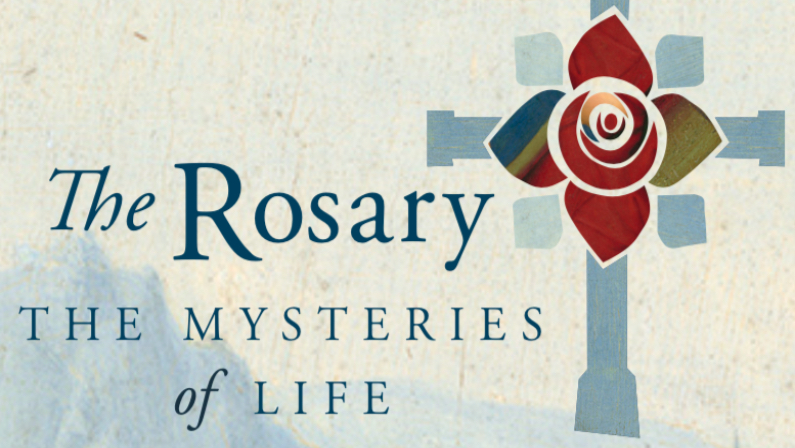
“The Rosary: The Mysteries of Life,” with Fr. Liam Lawton (Sing Amen! the podcast, episode 22)
Podcast: Play in new window
Today we have a special podcast episode to celebrate the month of the Most Holy Rosary, which is October. Father Liam Lawton has produced a new recording entitled “The Rosary: The Mysteries of Life,” (CD-1075) which will be released by GIA in the very near future. This project, recorded by Fr. Liam and the Poor Clare Sisters of Carlow, Ireland, contains a meditative reading of all four of the Mysteries of the Rosary—the Joyful Mysteries, recalling the birth and early life of Jesus; the Sorrowful Mysteries, focusing on the Passion and death of Jesus; the Glorious Mysteries, which focus on the Resurrection and the birth of the Church, as well as Jesus’ relationship with his mother; and the Luminous Mysteries, which highlight some of the great episodes in Jesus’ public life and ministry.
In a world full of complication and busy-ness, I have a feeling this project of Fr. Liam’s could be a great gift to many people of faith. It is beautiful but very very simple: it is, quite simply, a praying of the Rosary. For each decade of the Rosary, Fr. Liam offers a reflection on the particular mystery being prayed, and listeners are invited to join in the series of prayers (the Our Father, ten Hail Marys, and one Glory Be) with the Poor Clare Sisters, through the five decades of the rosary prayer. (This is also, by the way, is a lovely opportunity for connection with with these women, members of a cloistered order who live their lives within their enclosed community and open their hearts in prayer to all who visit or write them—As we pray for and with them, and each other, we invite one another to sink down into this meditative centuries-old prayer form.)
All four sets of mysteries will be included on the complete 2-CD resource; this podcast will include a praying of the Glorious Mysteries, taken from the recording.
So we invite you to take half an hour or so out of the busyness of your day to join in prayer—peace be with you!
The prayers and music for today’s podcast are taken from:
The Rosary: The Mysteries of Life, CD-1075
Sing Amen! the Podcast, with Jennifer Kerr Budziak
Sound by Jim Bogdanich
Sing Amen! opening music: Promenade, by Bob Moore (from Let Every Instrument Be Tuned for Praise, CD-491, from Liturgical Suite #4, G-4789 ©GIA Publications, Inc).
Sing Amen! closing music: Amen, (from More Sublime Chant, CD-459, The Cathedral Singers, Richard Proulx, conductor. ©GIA Publications, Inc.)
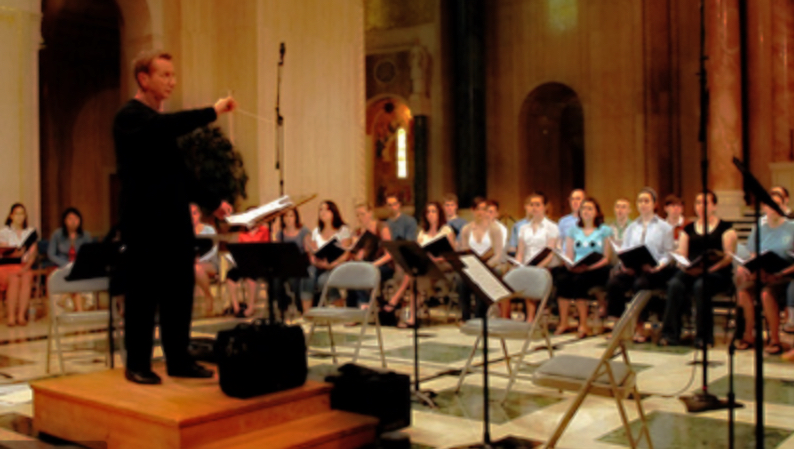
In Memoriam: Dr. Leo C. Nestor
In a binder on a bookshelf in my basement, I have about a three-inch-thick stack of psalms, Gospel verses, and new plainsong settings from my years singing with the Choir of the National Shrine under Leo Nestor. On any given Sunday, he would dash off these one-off pieces of music in his elegant and mostly-legible manuscript, and hand them to the choir and cantors. We were lucky to get a single read-through before we had to sing them for liturgy, and it was expected to be perfect—not just notes and words, but musicality and phrasing and good breath support. These were added to the two anthems and choral Ordinary we sang every Sunday. There was one rehearsal during the week, a warm-up on Sunday, and little repeated repertoire throughout the year. My first month with that chorus was the most extreme sight-reading boot camp I could have imagined. However good I thought I was when I got there, I quickly realized how high the bar could actually be.
And over time, surrounded by some of the most gifted musicians I have ever had the privilege of singing with, under the baton of a gifted and committed shepherd, I learned how to rise to that bar. That rehearsal space became my first real classroom for learning about the skill and art of choral music, the marriage of craft and love and intense focus, the glory that could be created by a group of people all working together to create beauty.
The Shrine was my classroom; Leo was our teacher. He was director, composer, conductor, martinet, dispenser of the most eloquently crafted criticisms I had ever known before or since, theologian…others can add to the list, which could go on for pages. But first and foremost, and years before professorship was officially conferred on him by Catholic University, he was my professor, my teacher, and that is how I remember him.
When I started undergraduate studies at Catholic University as a piano major, I had no idea that “professional choral singer” was even a Thing. I knew I loved to sing, and I knew I could sight read, but my high school choral experience had been…well, we’ll just say it was pretty negative and leave it at that. But for whatever reason, I decided to audition for the choir of the National Shrine of the Immaculate Conception right next to the music school. (At the time, it was not a Basilica yet.) I was incredibly young, incredibly green, and I knew almost nothing. I remember, when I went in for my audition, that Dr. Nestor was nothing like I thought he would be, and I remember that I was terrified. I remember he was younger than I’d expected (I had of course assumed he would be ancient, because choir directors in cathedrals were always ancient, at least in the mind of a 17-year-old), and that he had the razor-sharp look in his eyes that you sometimes see in the eyes of your best professors, the ones who don’t miss a thing. I remember that he was basically very kind to a terrified freshman who had no idea what she was doing there. He handed me I think a Palestrina motet and told me to sing the alto part, while he sat at the piano and played the other three parts. I made a mistake in the first few bars, stopped and apologized, and assumed we would stop and go back…but he just kept playing. I jumped back in and finished the piece with him. Once I forgot to be terrified and just read what was on the page, I did fine. I guess. In any case, he let me into the group.
Over the next four years that choir was the primary locus for my musical growth. I say that not to diminish what I was also learning next door in the actual educational institution I was enrolled in, but this was where I got to experience what I was learning in real life—when I studied renaissance counterpoint in class, I came to Leo’s choir and sang Palestrina and Marenzio and Morales and Hassler…when I studied the Well-Tempered Clavier in my lessons, I would at the same time be singing movements from Bach cantatas or motets. That ensemble was better than any history of choral music literature course I could ever have taken. (And, as I have said, all the music-making was at an extremely high level, from the first downbeat. If one dared to make a mistake even on the read-through, one quickly learned to stop the wrong note before it actually came out, or preemptively silence the misplaced consonant. If one dared to make a mistake on the second or third time through, then God help one.)
But most of all, this choir was where I first discovered the art and craft of the choral conductor—it was the first time in my life I got to sing under a musician who took it as a given that we knew what we were doing, and who saw his role as infinitely more than a traffic cop or time keeper; he gathered up the music inside of him, his mind and heart and inner ear, and let it flow out of his body to his ensemble, and received our singing back through himself to those who were listening. It was the first time it occurred to me that a conductor’s “communication” could be more than a system of direct signs expressing a distinct reality about when to start and when to stop and how loud or soft or smooth or articulated we should sing–rather than communication, what Leo gave us was communion, hearts and minds and brains moving and making music together. It was when I realized that one could catch a suspension with a pinky finger and stretch it gently to resolution over the bar line, or that an isolated syncopation in the tenor part could be carried in the tiniest twitch of a shoulder or collar bone. And it was where I realized, with a surety I rarely felt before or since, that that was what I wanted to do.
I have been reading some lovely tributes to Leo over the past few days, memories and stories and accountings of many of the amazing things he accomplished in his life. The man was brilliant—not just musically, but in a whole-brain sort of way. His command of language was sharp as a scalpel and often wicked. Even when he was dressing down a choir—some might say, especially then—he put words together with an elegance and verbal acuity the like of which I have never encountered before or since. Most who know of his musicianship know him as a composer, and he leaves behind a body of work that I hope will remain in the repertoire and continue to be sung, early and often. And obviously most of those tributes come from the many who knew him much better than I did, on many levels. I had already left Washington for Chicago when he began teaching at Catholic University; I never got to know Leo the professor, or watch him grow into and live that identity. But those of us who sang for him, especially over time and years, knew a part of him that could never be communicated another way. There is a vulnerability, an intimacy, when you stand in front of a group of singers and generate music-making, in which you let yourself be known and seen, and Leo taught me that too.
I am a conductor now, and a teacher of conductors. My gestures, which for so many years looked a lot like Leo’s, have settled into their own shape and style, though I still occasionally feel my pinky finger catch hold of a particularly lovely 4-3 suspension or become aware of myself choosing from among the dozen or more options I picked up from him for indicating a cut-off or release. My gratitude for all the wonderful teachers I have worked with in the years since Leo helped me with my first grad school auditions (I basically followed him around like an eager puppy and asked endless questions until I think he started giving me unofficial 5-10 minute conducting technique lessons in self-defense) is immense, and I have been incredibly fortunate. But my first and most important conductor-learning came from him.
Monday morning on my Facebook page, I posted the following:
Many of us, if we were lucky, had a First Teacher, the one who opened that first window, who let us feel that first breeze, smell the air for the first time, who pointed us to the door and handed us a key and said, “Go on, there’s stuff for you to do out here.” And smiled as they watched you open it, step out, and take flight.
We lost mine yesterday. Ruhe sanft, Leo.💔
Eternal rest grant your servant, O Lord, and let perpetual light shine upon him.
–Jennifer
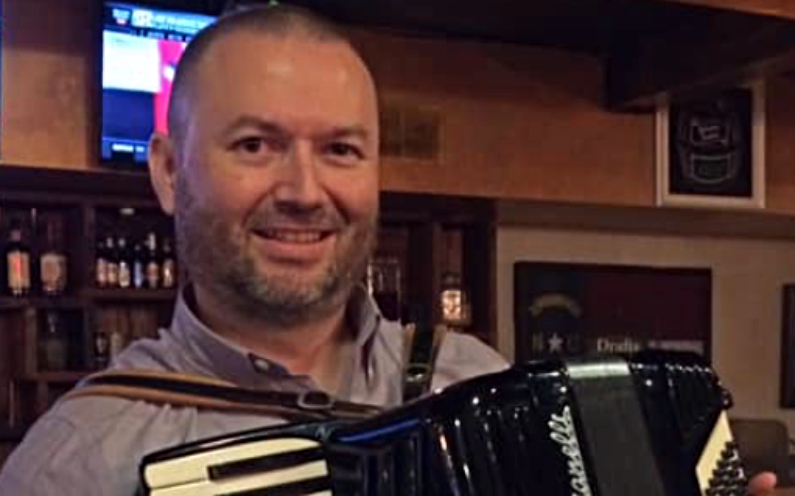
¡Cantemos Amén!–A Conversation with Peter Kolar (Sing Amen! The Podcast, episode 21)
Podcast: Play in new window
This past summer, GIA welcomed our new Editor for Spanish and Bilingual Resources, Mr. Peter Kolar. Today’s podcast is a conversation with him about his life and work and his reflections on his experiences of music ministry within bilingual and multicultural communities. He was one of the directors for the GIA Showcase at NPM last summer, and he’s been active in NPM conferences for years, giving workshops on bilingual and Spanish music. He is a composer in his own right, and he has his own blog here on the Sing Amen site, called ¡Cantemos Amén!, so please look for his voice to keep adding to the conversation here at singamen.giamusic.com.
Shortly after he started at GIA, Peter and I sat down and recorded this podcast interview, which we’re sharing with you today. Obviously this conversation happened well before the tragic terrorist attacks in El Paso last month, which Peter wrote about in his last blog post, so if you have not read it, please do; it’s a beautiful reflection on the strength and love of a rich and faith-filled community, and it can be found here.
I’ve known Peter Kolar for more than 20 years, and he’s one of my favorite people, so just sitting down with him to talk about life and ministry and everything was a treat for me, and getting to hear snippets of recordings from his days directing a youth marimba ensemble in Chicago’s Back of the Yards neighborhood is a special bonus! I hope you enjoy this as much as I did.
Music Heard on today’s Podcast:
—”Chiapas” (Mexican traditional) and “Invention in A minor” (J. S. Bach), performed by the Marimba Ensemble of Holy Cross-Immaculate Heart of Mary Parish, Chicago, IL.
—”Improvisation on ENGELBERG,” ©2019 Peter M. Kolar
Sing Amen! the Podcast, with Jennifer Kerr Budziak
Sound by Jim Bogdanich
Sing Amen! opening music: Promenade, by Bob Moore (from Let Every Instrument Be Tuned for Praise, CD-491, from Liturgical Suite #4, G-4789 ©GIA Publications, Inc).
Sing Amen! closing music: Amen, (from More Sublime Chant, CD-459, The Cathedral Singers, Richard Proulx, conductor. ©GIA Publications, Inc.)
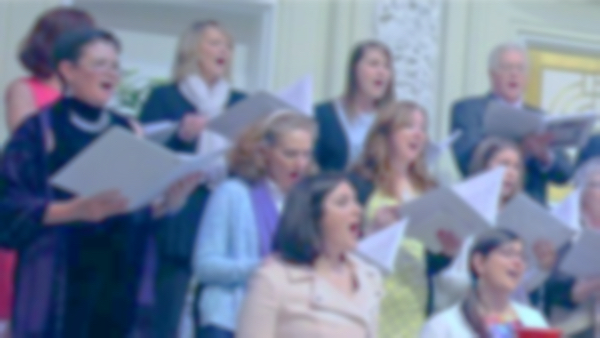
Choir Membership: Open to All, or Auditioned?
On the one hand, we are ministers, singing in the church choir is not like concert performance, and we want to be hospitable and welcoming to those who feel called to serve. Shouldn’t everyone who wants to sing be able to join the choir?
On the other hand, what if someone who feels called to serve is unable to match pitch, or sings perpetually flat, or sticks out of the texture with a loud and wide vibrato?
For many of us, it’s the start of the choir season right about now, and most of us have at some point in our life as ministers needed to address the potential conflict inherent in the two questions above in some way. For some, it’s easy, and the answer is self-evident; we don’t even have to think about which direction we go with this question. Perhaps, if we are honest with ourselves, we may have harbored a little judgment in our hearts about those different from us who fall in the other direction? (Maybe not. 😉 )
For myself, as with many things, my preference is to take a both-and or middle-of-the-road kind of approach to choir membership. The word “audition” can feel threatening or loaded, filled as it is with the inevitable framing of the end result: do you make it in, or not? Are you good enough, or not? On the other hand, I learned many years ago that it wasn’t good for anyone when I just invited people to show up, and dropped them into the choir immediately without knowing anything about their experience, skills, voice type, ears, and so on.
So when someone new steps forward wishing to join the choir, I do not have an “audition” per se, or rather, I don’t call it that. I invite them to come in for a few minutes so I can “hear their voice and get a sense for where they will fit best.” Essentially, I want to know who they are, what they sound like, and whether they will be able to handle the demands of the ensemble–demands established not by me, but by the members themselves and the rhythm they have been happy to settle into over the years. I have been fortunate enough to direct choirs whose singers, while they love ministry, also come because they love music and singing and being part of an ensemble that can challenge them to do the kind of singing they can’t do in the rest of their lives. Rehearsals tend to move pretty quickly, and we spend our time well and efficiently.
When I do a “voice check” (what I informally call the not-audition meeting) with a new singer, I generally begin just by asking them to tell me about themselves, where they came from and what kind of singing they have done in the past and why they enjoy being part of a choir. I ask them if they have any experience reading music, reinforcing that this is not a deal-breaker at all and that many choir members are not strong readers, but that it’s good for me to know. I ask what voice part they usually sing. Then I will vocalize the singer up and down the scale: I start sort of mid-range and take them down into the lower register first, and then up into the higher register. Fairly frequently I’ll hear an “alto” whose vocal color suggests that they might actually be a soprano, but they are not comfortable with higher pitches; a little voice work and vocal tech to help them open up and lift the soft palate often works wonders, even in just a few minutes.
I also often invite them to sing something they like–any hymn or song, just so I can hear their natural voice. (I tell them about this beforehand, so I don’t catch them off guard.) And then I teach them a refrain or a verse of some piece we are working on–this gives me a chance to see how quickly they pick up something new, whether by reading or by ear. If they can sing it with confidence along with my voice and the piano, I stop singing and see if they can sing independently with the piano; if they can do that without difficulty, I’ll try harmonizing the alto part along with them to see if they can be independent even with another voice part going next to them. The idea is to just give them a little time to make music, just a two people singing together.
The whole process generally takes maybe 15-20 minutes, and it’s actually kind of fun. (Well, it’s fun for me; the level of relaxation and enjoyment the singer gets out of it seems to vary.) And it’s enough to give me a solid sense of who the person is and what kind of sound they have–beyond “you’re in the choir/you’re not in the choir,” going a little deeper. I get to to know them a little as people rather than just as “a voice,” and I get to learn what section they should be in, where they should stand, whether they will go high or low if a part splits…It helps me figure out what voices might be good to pair with theirs, whether they are the voice to put next to the less strong voices or whether they will need to stand next to someone who is really solid on their part in order to be confident.
And occasionally…it tells me that this person is simply not ready for this ensemble. And those are the tough ones. Because if they are not ready, they are not ready. And they should probably not join.
I can hear a few people drawing up to argue with me here, to call me exclusionary, to tell me that music and ministry are for everyone–and in a way they are right, everyone should have the opportunity to raise their voices and sing praise to God with a joyful new song…
But…hear me out. Yes, we are ministers, and we are hospitable, and we are pastoral. But sometimes a kind and loving “I do not think this would be good for you right now” is the most hospitable response we can give. For a lot of reasons.
First: Ultimately, the parish musical leadership has a responsibility to one another and to the assembly, to be able to lead them in making music. If the leadership is not solid, then not only does their music suffer, but so does that of the entire assembly. This is not about creating a “better musical performance”–not at all. This is about solid leadership, and making sure those who stand wherever they stand and support the assembly’s singing are fully able to do this–or at the very least, have the potential to learn to do it and not impede the overall leadership ability of the choir as they do their own growing.
Second: If the liturgical ministries of the parish are true to their mission of raising up the voice of the body of Christ, helping bring them to full, active, and conscious participation, then those in the pews are singing as well. There should be no sense that suggesting that the choir may not be the place for this new singer means that they are not to sing–on the contrary, if every person in our parish who could carry a tune was in the choir, there would be no assembly. (Yes. I firmly believe this.) If no one but the choir sings for your parish liturgies, that is the sign of a problem that goes much much deeper than whether this individual is ready to join the parish music ministry.
Third: if an ensemble of music-makers has found its rhythm, its speed, its style, and its way of working, and a new member comes in who is not equipped for it, it’s not just a question of disrupting that flow for those who are already in the group–the new member will invariably sense it too, know that they are not keeping up, know that they are not succeeding. And this can quickly become stressful and toxic–to the individual, to the ensemble, and to you as leader. This is no way to approach song and singing. We need to set our singers up for success, all the time. To say “yes” in the name of hospitality, knowing in advance that it sets up not only your existing group of singers but the new members themselves for something that is not success–this is, in the end, doing all of them, and the assembly you and they serve, a disservice.
It’s not an easy conversation, to be sure. Often I suggest to the hopeful chorister that they consider a voice class or voice lessons, just to get a better sense of how their vocal instrument works, and get more comfortable with making and tuning their vocal sounds…if they have pleasant voices but as yet lack the ability to pick up new music quickly, I always have the name and number of a director of a local community chorus to give them–a group responsible for one concert of music every few months, rather than a Mass every single week. If they are just on the edge of being able to be successful but not quite…I might invite them to join the choir for Christmas Eve, which is when we have a body of set repertoire that we get more extended time to work on, with specific rehearsal days and times. Sometimes I give the new singers themselves this choice, and say, “This feels like a big step for you to take right now, since things in the Sunday group are moving so fast, but I don’t want to discourage you or send you away–how would you feel about maybe joining our Christmas choir now, and seeing how that feels; if you like it and feel comfortable, then maybe you would want to step into the weekly choir come January?”
All of that said–most often, those who step forward wishing to join the music ministry in most places I have ministered are capable, and once they get past the early learning curve of picking up the music the larger group already knows, they are absolutely fine. If a non-reader (or even a reader, for that matter) wishes to join the group, I always warn them that we will pretty much never rehearse the well-known hymns and/or service music, and not to worry about it–I say, just do your best to keep up and be assured that those who have sung these pieces 284 times have got your back, and you will pick it up; a few years ago, they were the ones who didn’t know the music and they leaned on the solidity of the veterans while they learned it, and that’s how the church choir works. I suggest that they sing “under the radar” for the first few weeks until they learn to read the unspoken signals and assumptions, of which there are many, and which I will doubtless not remember to warn them about. I reassure them that the other members of the group will help them learn the ropes, and to not ever fear to ask questions, either of me or of their singing colleagues. I make sure I check in with new members a few weeks in, and then a few weeks after that, to see how they are doing and if they are getting more comfortable. And if it brings them joy.
We are ministers. Singing in the church choir is not like concert performance, it is a ministry of servant leadership, and it requires time and preparation. And we must always be hospitable and welcoming to those who feel called to serve.
How does this work in your parishes? I’d love to hear from others how they view this process, and what your method is in your own ministry–so please leave a comment!
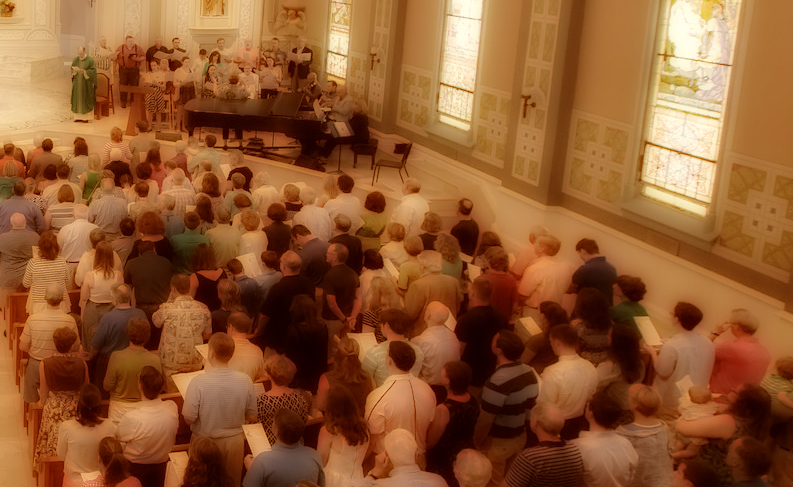
Multi-Generational Music Ministry
On Thursday morning at the NPM Convention in Raleigh, NC, I was privileged to sit on a panel with some really wise and insightful people; the topic was multi-generational music ministry, and how it could work in our various parish situations. Probably the most exciting thing about this panel was how many people came to it—we had a full room, so clearly this is a topic that touches the ministerial lives of a lot of people. I would like to share a few thoughts here, particularly for those who were unable to be there last week.
One of the questions we addressed as a group was this: “We are in a time in history where people are often segmented from each other. What are the benefits to having a multigenerational vocal ensemble?”
Several of us spoke to address this question, but the overall gist seemed to center around the fact that each age group has something to learn from the others, that our different wisdoms enrich one another in a way that remaining separate cannot. Children learn faith from their elders—not by classroom learning, as one of the panelists said, but they “catch” faith from those around them; it’s contagious and it spreads. This whole question also resonates with the idea of the wholeness of the Body—the Body is many parts, but we are all together and all one. As Rahner says (though admittedly I will be mangling him in the paraphrase), we come together in Sunday liturgy to “rehearse” for the liturgy of the world, the great and grand liturgy we celebrate when we leave the walls of the church. If within the church we rehearse and experience and sing and celebrate the reality of everyone being one, this helps and creates the reality that oneness envisions. It’s too easy to let “them” be separate from “us”…but if we can come together and experience one another’s gifts and wisdom, we will all be better humans.
Another question spoke to the practical side of bringing together seniors, adults, teens, and children, the challenges involved and the question of who needs to be “on board” to make it happen. This was an interesting question, and one which I wished we’d had more time to dive into, because the answer, while fairly straightforward, can play out different ways. The obvious, no-brainer answer to who needs to be on-board is of course going to be, “the music ministry/music director.” But there are a lot of different kinds of music ministries, with different staffing models.
In my last parish, when I was full time there (a model which I am aware increasingly few churches are able to sustain), I directed all the choirs—adult, teen, and children. The parish before that, there were two of us; I had the adults and the older children, and a colleague (who was also a really good friend, and a super person to work with) had the youngest children and the teens. In both of these situations it was incredibly easy to have the groups work together, because there weren’t too many chefs in the kitchen or people to coordinate.
On the other hand, in a parish situation where there are different part time musicians leading the children, the teens, the adult Sunday morning choirs, and the Saturday afternoon contemporary ensemble, it gets trickier. Everyone is a little busier, every schedule is a little more crazy, and the likelihood of territorialism or drama begins to rise. It’s harder to find times to gather people, and unless all the players have over time developed an excellent working relationship and a solid basis of consistent repertoire, there may not be enough consistent repertoire to rely on. (That said, developing that consistent “Parish Top Ten” body of rep that everyone knows is a really good idea for helping your whole music ministry be more able to function in moments when varied groups come together.) Here there will need to be more planning, more coordination, and possibly more good-will across the board…but it is still possible, and very much worth the challenge.
My favorite set of questions on this topic came all sort of in a group: How often do musicians get an opportunity to reach people who might become regular members of your choirs? Musically, does a separate ensemble need to be organized to make this happen? Or, is there a chance that a few rehearsals can be called and people can commit to a very specific period of time?
In all frankness, questions about unity and spirituality and becoming what we believe aside, it is my belief that multi-generational special-event choirs are the single best recruiting tool any choir can ever have. Not everyone can commit to weekly rehearsals and choir membership—and someone who could do it five years ago maybe can’t do it now, but maybe they will again when their kids reach high school age. Life circles around and seasons change, but it is a tremendous gift to be able to stay connected with music-lovers at all stages of their lives.
Following are several potential multi-generational opportunities with incredible potential for recruitment and outreach:
- Thanksgiving Day
Many parishes have a “special” Thursday morning Thanksgiving Day celebration. These tend to be joyous and well-attended, and everyone who comes is there because they want to be there. This is the perfect opportunity to invite all of your choirs, of all ages, to come together, and to bring family members who might not already be in one of the groups. Sing music everyone is fairly familiar with, and hold one rehearsal a few days before the day (Wednesday night tends to lose anyone with family coming into town)—with snacks and plenty of social time. All of your age-groups of people get to make music together, and this one day provides an easy and low-stress opportunity for newcomers.
- Christmas (or Christmas Eve)
The biggest draw for this one, I have found, is the guarantee of the best seat in the house on the most crowded church day of the year. Invite a group to come together, adults and children, seed the group with a few of your solid part-singers (and their kids and/or grandkids), and sing familiar carols. Let your most advanced choir sing for Midnight Mass, but let the earlier “Family Mass” be relaxed and celebratory; alternatively, track down parishioners who love to sing but don’t want to brave the Christmas Eve crowds, and invite them to come back on Christmas morning. It’s a wonderful thing, and a happy day for all.
- Summer Choir
In last year’s book Gathering Gifts, Building a Program,there is an article by Michael Silhavy about his practice of forming a “Summer Choir” in his parish every year when the regular groups take a break. This is a wonderful opportunity to give the year-round choir a little time to relax and not be “on,” and to invite anyone of any age—families, adults, kids, teens—to come on a Sunday to Sunday basis as they are available. They can come an hour before Mass, learn an easy anthem (chosen for its flexibility, because of course in this model one doesn’t know exactly who or how many will be there), sing the hymns, have hospitality and donuts before Mass and get to know each other a little, and then sing. Some will very likely decide to stay into the fall, if their life permits.
- First Communion
This one is probably my favorite. In one of my former parishes, I would put out a sign-up sheet a few weeks before the parish First Communion celebrations and beg my choir members to sign up to sing one or both of our big Masses; it also went onto the Children’s Choir calendar back at the beginning of the season. Honestly, after the first year I didn’t have to beg; people had a wonderful time (and we gave them lunch)(Feel free to take note of how many of these suggestions involve food of some kind). The witness of that mix of adults and children, leading song and singing familiar music while the young Communicants came to the table for the first time, made, I think, a deep and lasting impression on everyone there. The celebration was not just about the children and their “special day,” isolated from the rest of their life as Christians, but rather it was in the midst of their community; the children were supported by not just their families but the whole parish. And we would invite to sing with us family members of those who were coming to the table as well, so we usually had at least a few people from neighboring parishes who sang in the choirs there, and we got to make connections from parish to parish and be welcoming and hospitable to new friends in our midst. It was wonderful.
Bottom line—if your parish has not explored the idea of pulling together a multi-generational choir, for special events or through a season…maybe this year is the time?
Deep thanks to Christopher Titko of J. W. Pepper and Berta Sabrio of NPM for convening this panel and making it possible!
UPDATE AND POSTSCRIPT: A few people have commented on the Facebook page that in their parish situations the diocesan guidelines for adults needing to take “safe environment” trainings and be certified to even be in the room with minors has made this entire proposition a lot more complicated than just going, “Let’s put us all together!” I am curious how people have found a way to make this work?

Guide Our Song: An Adam Tice Sampler (Sing Amen! The Podcast, episode 20)
Podcast: Play in new window
One of the great gifts to the singing Church in more recent years has been the wonderful outpouring of new hymn texts by our modern poet-theologians–people like Delores Dufner, Mary Louise Bringle, Herman Steumpfle, Sylvia Dunstan…and over the past decade or so, Adam Tice. Adam’s texts are rich and challenging, addressing many of the challenges and darknesses facing our world today. His words are unflinching and yet full of hope, and it’s no wonder so many composers who encounter his texts are moved to set them to music.
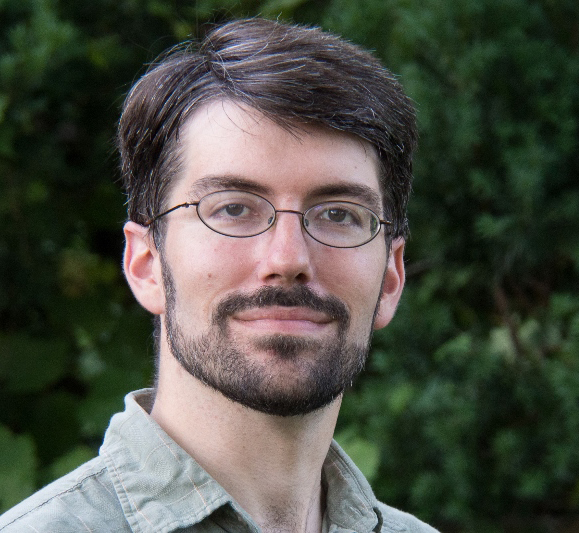
This podcast, rather than being composer-based or genre-based like many others have been, will instead focus on the text-writer; here are ten songs set by a varied body of composers, all set to Adam’s texts. There are rather straightforward assembly-based hymns here, as well as choral pieces. Some of these selections are more “traditional” in style, while others lend themselves more to a contemporary ensemble’s sound–but all are lovely, and all give one much to think and pray about. (He’s also an incredibly nice guy.)
If you enjoy this, I highly recommend checking out his full collections of hymn texts: Woven Into Harmony, Stars Like Grace, A Greener Place to Grow, Claim the Mystery, and his latest, Pulse and Breath.
Peace to all!
Music Heard on this Podcast:
God of Music, Guide Our Song, G-8092
Text Author: Adam M. L. Tice
Text Author: Adam M. L. Tice
God, Give Me Faith like a Child, G-8591
By Sally Ann Morris
Text Author: Adam M. L. Tice
As recorded on Walk in Peace, CD-908
In the Morning, in the Evening, G-9873
by Bex Gaunt
Text Author: Adam M. L. Tice
As recorded on Womb and Tomb,CD-1061, and Show By Your Life, CD-1054
Text Author: Adam M. L. Tice
One Thing I Ask of You, O God, G-9835
by Gary Daigle
Text Author: Adam M. L. Tice
As recorded on Way, Truth, and Life, CD-9866
For God So Loves the World, G-9201
by Marty Haugen
Text Author: Adam M. L. Tice
As recorded on Pilgrims and Companions, CD-1020
From the Waters I Will Rise, G-9859
by Marty Haugen
Text Author: Adam M. L. Tice
As recorded on Choose to Hope, CD-1060
Glorify the Lord by Our Lives, G-8907
by Tony Alonso
Text Author: Adam M. L. Tice
As recorded on A House of Prayer, CD-968
Special Bonus Track:
Peace to You, My Loved Ones
By Sally Ann Morris
Text Author: Adam M. L. Tice
(recorded live at Laurelville Music and Worship Leader’s retreat, an annual Mennonite event that takes place in western Pennsylvania. Click here for the video!)
Sing Amen! the Podcast, with Jennifer Kerr Budziak
Sound by Jim Bogdanich
Sing Amen! opening music: Promenade, by Bob Moore (from Let Every Instrument Be Tuned for Praise, CD-491, from Liturgical Suite #4, G-4789 ©GIA Publications, Inc).
Sing Amen! closing music: Amen, (from More Sublime Chant, CD-459, The Cathedral Singers, Richard Proulx, conductor. ©GIA Publications, Inc.)
Why Do We Sing?
By: Diana Kodner Gokce
Explore Sing Amen
Looking for more great resources, articles, podcast, and more throughout all Sing Amen blogs? Search through the site here.
Search By Category
Search Archives

